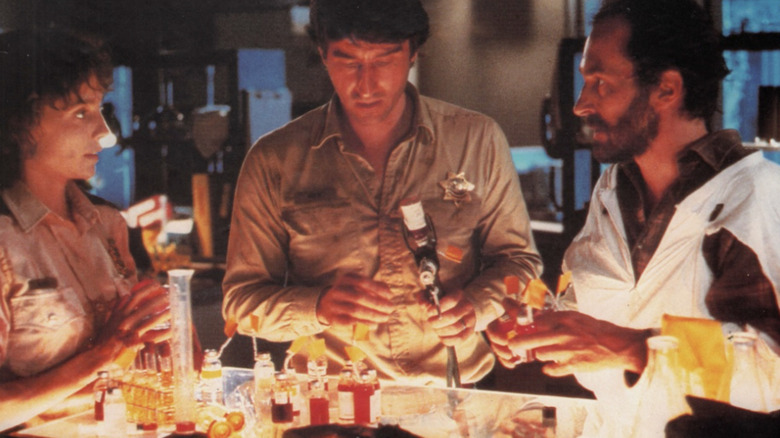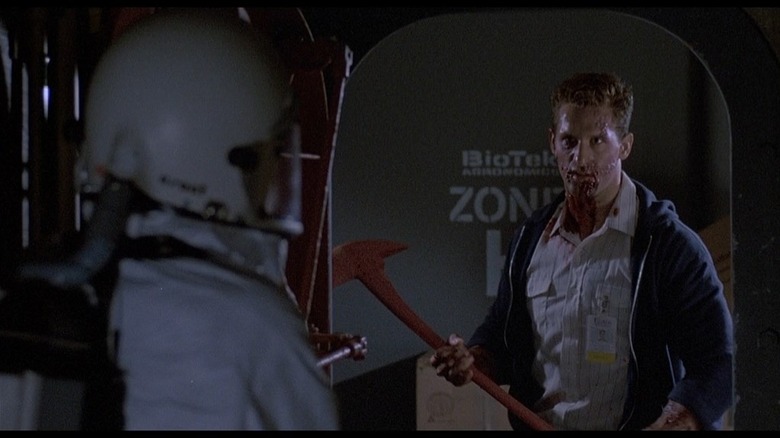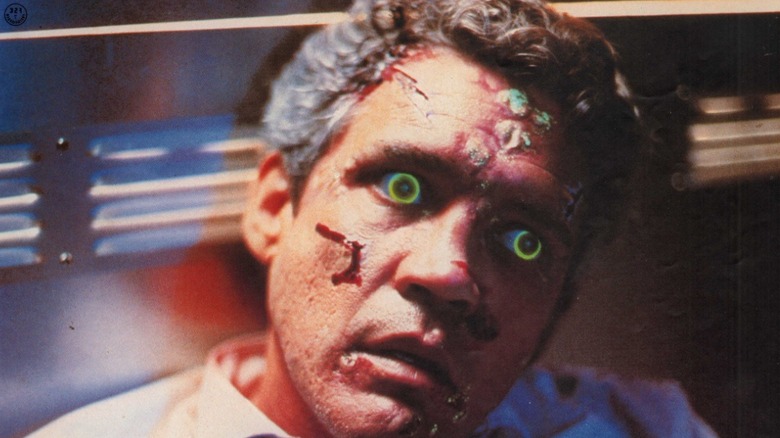This Forgotten Rage Virus Movie Came Before 28 Days Later (And Has A Sly Star Wars Connection)
The zombie movie underwent some fascinating changes during the 1980s. Ever since George A. Romero's "Night of the Living Dead" established the zombie as we know it today way back in 1968, the general concept of the zombie hasn't wavered much — they're the re-animated dead who hunger for flesh and/or brains, and so on — but there have been numerous permutations regarding the origins, behavior, and rules of zombies. Romero's "Night" and "Dawn of the Dead" presented the advent of a zombie outbreak as something supernaturally mysterious, and many subsequent films followed suit, especially Lucio Fulci's zombie flicks. Yet others took a more direct approach to the creatures' origins, with the likes of David Cronenberg's "Rabid" (1977) and Umberto Lenzi's "Nightmare City" (1980) adapting the viral behavior of Romero's zombies (i.e. if you're bitten, you're infected and will become a zombie) into literal plagues.
40 years ago, in August of 1985, two movies were released that took a look at a viral zombie outbreak through a distinctly Americanized lens. Dan O'Bannon's "The Return of the Living Dead" saw zombies crop up in a corner of Louisville, Kentucky, thanks to a misplaced vat of a fictional bioweapon developed by the US military called Trioxin accidentally being opened. While "Return" has enjoyed a beloved cult status ever since its release thanks to its fantastic makeup effects and satiric sense of black humor, the other August '85 zombie outbreak film has almost been forgotten: Hal Barwood's "Warning Sign." The film may not be as raucous as the punk-rock "Return," but it's no less important to zombie movie lore. That's because, in addition to its pedigree of filmmakers, it acts as both a callback to a "Star Wars" bit of trivia and presages the "28 Days Later" series. In the film, the secret government project that causes a small but deadly outbreak of a zombie-like virus is dubbed "Blue Harvest," which was originally coined by Lucasfilm as a faux title when "Return of the Jedi" was filming. Additionally, the origin of the zombies in "Warning Sign" isn't nuclear waste or a toxic re-animating gas, but is instead a virus created to trigger unmitigated rage in a living animal or human, which is almost identical to the origins of the Infected virus in the "28..." franchise.
Warning Sign pays off the Lucasfilm inside joke of Blue Harvest
When "Return of the Jedi," the third movie in the original "Star Wars" trilogy, was gearing up to start filming in the United States in late 1981, the local press in Yuma, Arizona began reporting that the next "Star Wars" was due to shoot in their area soon. According to an article on the Lucasfilm website, this caused co-producer Jim Bloom to go the extra mile in hiding the production from the press and public. While the film had a working title of "Revenge of the Jedi" (that would later be changed to "Return of the Jedi"), Bloom devised a code name for shooting, which was "Blue Harvest." Not only did the co-producer have hats and patches specially made for the crew to wear during shooting, they also came up with an official tagline intended to further throw the media off the scent: "Horror beyond imagination." Clearly, the hope was that the press wouldn't snoop around a set of an unknown horror movie. While the ruse mostly worked, the jig was given up at San Diego Comic-Con in 1982 by producer Howard Kazanjian after filming had finished.
While "Blue Harvest" has become a trivia question and in-the-know reference for "Star Wars" geeks ever since, Barwood did them one better just a couple years after the release of "Jedi" by sorta kinda actually making "Blue Harvest" a reality. This wasn't just a nerdy reference, either, as Barwood, along with co-writer (and director in his own right) Matthew Robbins, was pals with George Lucas from back during their film school days. Barwood has been a part of Lucas' creative circle ever since: he worked as an effects animator on Lucas' debut feature, "THX 1138," and co-wrote (along with Robbins) Steven Spielberg's debut theatrical film, "The Sugarland Express." Later, Barwood began working at Lucas' spinoff video game company, LucasArts, where he helped make successful games in the "Indiana Jones" and "Star Wars" franchises.
Adding to all of this is the fact that Jim Bloom is one of the producers of "Warning Sign" alongside Barwood. So, using the name "Blue Harvest" for the secret government project within "Warning Sign" is as much an inside joke between friends as it is a geeky reference to "Star Wars." Indeed, Bloom and Barwood apparently did at one point consider calling the movie "Blue Harvest," which would've been one of the first (if not the first) instances of a fake movie becoming real, a la "Machete" and "Thanksgiving." Still, the fact that "Blue Harvest" is still a part of the movie itself is enough to say that, in a way, the fake horror movie eventually became a real film.
28 Days Later and Warning Sign have much in common
According to the October 1985 issue of Cinefantastique, Jim Bloom saw "Warning Sign" as "a cross between 'The China Syndrome' and 'Night of the Living Dead,' which is a fairly accurate description of the film. As with those examples, "Warning Sign" is primarily a single location thriller, with the majority of the movie taking place at the Biotek Agronomics facility in Utah, whose cover is as an agricultural research center but is actually a facility working on a bioweapon for the military. That weapon, it's revealed, is a virus that was genetically engineered from the DNA of some wild horses who were uncontrollably aggressive. The idea was that such a virus, if created to be contracted by and affect humans, would make them so aggressive that they'd violently and uncontrollably attack and murder everyone around them just a few hours after infection. Thus, the zombie-like virus in "Warning Sign" isn't something which brings the dead back to life and makes them hungry for human flesh, but instead unleashes unchecked rage within human beings. That's exactly what the zombie-like virus does in "28 Days Later" (and its sequels "28 Weeks Later" and "28 Years Later"), too. In that film, the virus is the result of scientific experiments on rage-filled chimpanzees, and both movies demonstrate how one tiny incident can be responsible for a world-threatening outbreak.
While both movies seem incredibly different on the surface — one is set mostly in the same place while the other sprawls across England, for instance — there are many similarities between "Warning Sign" and "28 Days Later" in addition to the origins of their viruses. For one thing, both films were released by a division of 20th Century Fox. For another, both movies included the biological hazard symbol as a key element in their marketing, indicating that these were films about viruses instead of the rise of the undead. (Ironically, Barwood originally wanted to call his movie "Biohazard," which would go on to become the name of a hugely popular zombie video game 11 years later, known to Americans as "Resident Evil.") The biggest similarity is how both films, despite clearly paying homage to Romero's initial "Dead" trilogy, do not follow Romero's lead with regard to a bleak ending. In "Warning Sign," a cure is found to the virus which allows its spread to be stopped, and while "28 Days Later" doesn't have as fully a happy ending, it still lets its protagonists survive the ordeal. "28 Days Later," despite being about a virus, is generally credited with reviving the zombie subgenre, and rightfully so. While "Warning Sign" is too obscure to share that title, it absolutely deserves more credit and attention.


